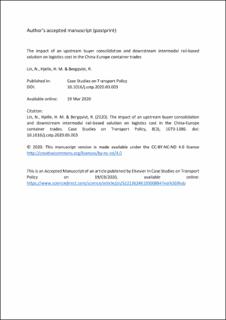The impact of an upstream buyer consolidation and downstream intermodal rail-based solution on logistics cost in the China-Europe container trades
Peer reviewed, Journal article
Accepted version

Åpne
Permanent lenke
https://hdl.handle.net/11250/2734640Utgivelsesdato
2020Metadata
Vis full innførselSamlinger
Originalversjon
Lin, N., Hjelle, H. M. & Bergqvist, R. (2020). The impact of an upstream buyer consolidation and downstream intermodal rail-based solution on logistics cost in the China-Europe container trades. Case Studies on Transport Policy, 8(3), 1073-1086. doi: 10.1016/j.cstp.2020.03.003Sammendrag
In the typical structure of the supply chains associated with the Asia-Europe container trade, containers are stuffed in China, and the cargo is subsequently cross-docked at a major European logistics hub or a distribution centre closer to the customer for further distribution to the final retailing points. However, this solution may not be optimal in the perspective of total logistics cost. Upstream buyer consolidation at the origin and a downstream rail-based intermodal system at the destination has been regarded as a potential solution for reducing the costs of supply chains. The purpose of this study is to identify the benefits of this potential solution. This research is based on a case study obtained from a Swedish retailer with a chain of retailing points in Scandinavia and Poland. A comparative analysis is used to reveal the cost advantage of the alternative solution. Our findings suggest that this alternative solution may reduce monetary logistics cost from two aspects: converting LCL shipments to FCL shipments and converting almost full 20-foot FCL shipments to 40-foot FCL shipments. In addition, certain non-monetary benefits of buyer consolidation, including reduced possibility of delay, reduced complexity, reduced carbon emissions and reduced activities in the destination countries, are illustrated in this paper. Based on our calculation, the cost-saving potential of the new alternative solution illustrated in this case study is considerable, which suggests that such solutions might be desirable as an alternative to the typical arrangements in this trade. Keywords: Upstream buyer consolidation; Rail-based intermodal system; Asia-Europe container supply chains; Monetary benefits; Non-monetary benefits.
